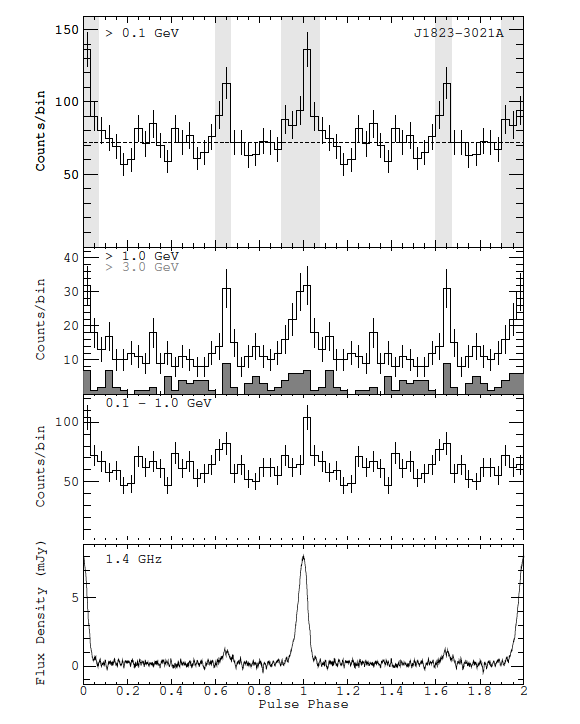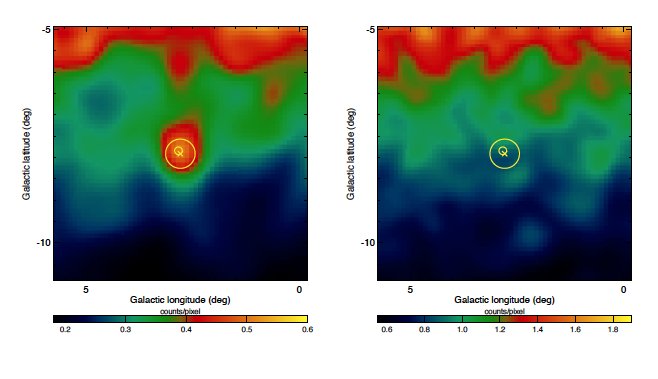Title: Fermi Detectiqon of a Luminous γ–ray Pulsar in a Globular Cluster
Authors: The Fermi LAT Collaboration
Principle Investigator: Dr. Peter Michelson, Stanford University
The Fermi Large Area Telescope, which was launched in 2008, is a gamma ray space telescope which can observe high-energy photons with energies ranging between 20 MeV and 300 GeV. These photons are emitted by particles nearing the speed of light! The Large Area Telescope (LAT) is true to its name, and can observe around 20% of the sky at a time. It scans the sky continuously, observing the entire sky every 3 hours. This all sky gamma-ray survey has already had many exciting results. It observed the GRB 080916C, the most energetic outburst ever seen (see Susanna’s post to learn more about gamma-ray bursts), discovered a link between supernovae remnants and cosmic rays, found out that most of the gamma-ray background does not arise from active galactic nuclei as was previously suspected, and it discovered Fermi bubbles, completely new (or at least previously unseen) substructures emerging from the Galactic center. In addition to all of this, Fermi LAT has proven fantastic tool for the discovery of pulsars.
Pulsars form during some type II supernovae events, and are spun up to high rotation speeds by some “kick” due to collapse or explosion asymmetries. They are also highly magnetized, and thus emit periodic synchrotron radiation in two beams. For a more in depth discussion of the observables of pulsars, see this astrobite. The first pulsar discovered, at the heart of the Crab Nebula, was initially observed in radio wavelengths. This was quite a discovery, so much so that it warranted the 1974 Nobel Prize in Physics. Since this initially discovery, astronomers have discovered pulsars in several other wavebands including visible light, x-rays, and gamma rays.
In the most basic description possible, there are two types of pulsars: millisecond pulsars (MSPs), or those with periods of 1-10 milliseconds which change very slowly, and ordinary pulsars. Both pulsars are formed by the death of a massive star, but MSPs are believed to exist in binary systems where accretion from a companion causes the pulsar to spin more rapidly. These pulsars are also sometimes called “recycled pulsars” because they are believed to be old pulsars. MSPs exist at higher rates in globular clusters, where the fraction of close binary systems is greater than elsewhere. This has been confirmed previously by the Fermi LAT collaboration where globular clusters have been detected in gamma-rays. Pulsar gamma-ray emission is a signature of pulsar emission due to magnetic fields, so this waveband provides a unique measure of the magnetic field strength of pulsars.
However, it is difficult to identify an individual pulsar with LAT. While the LAT has a very large field of view, it does so at the expense of angular resolution (which is a pretty good trade off if you want to scan the whole sky in 3 hours), but as a result, it would be difficult to separate out the emission based on spatial location. Typically, the observed gamma-ray emission from globular clusters has little variability because there are many MSPs emitting gamma-rays within the cluster. This is consistent with observations in other wavebands. For example, 47 Tuc contains at least 23 MSPs which are known from radio and x-ray observations. As a result, the LAT collaboration has not generally been able to place constraints on single gamma-ray MSPs, but rather an entire population contained within a given globular cluster.

Figure 1: Pulsar light curves for J1823-3021A. The bottom panel shows the light curve in radio wavelengths as taken by the Nancay radio telescope and the top and middle panels show different energy gamma-ray profiles as obtained by the Fermi LAT
This makes the news that the Fermi LAT was able to detect the emission of a single MSP in the globular cluster NGC 6624 very exciting. The pulsar, J183-3021A, had already been identified as the brightest radio pulsar in the globular cluster, and has been regularly observed with the Lovell and the Parkes radio telescopes since it was discovered. Additionally, it has been observed with the Nancay radio telescope since the Fermi telescope was launched.
As a result, the pulse arrival times for J183-3021A are well characterized. This paper presents an analysis which convincingly shows that this pulsar also dominates the gamma-ray emission in the cluster by aligning the gamma-ray and radio wavelength peaks as shown in figure 1. In addition to ensuring the pulse timings match, the authors also find that the position of J1823-3021A from radio observations is consistent with a bright and isolated gamma-ray source observed with the Fermi LAT.
Emission from J1823-3021 dominates the cluster gamma-ray emission. This means that previous analyses estimating the number of MSPs in NGC6624 are overestimated due to this single bright source. Previously, some authors had suggested NGC6624 had ~100 MSPs, a number which seemed much too high given the believed close binary fraction within the cluster. The authors of this paper have been able to revise this inconsistency, and estimate that there are <32 MSPs in NGC6624. The most exciting result in this paper, however, is the sheer brightness of J1823-3021. It is very rare to be able to align radio and gamma-ray observations of a single pulsar, and this has only been done for 3 MSPs to date (and the Crab pulsar). It is worth noting that NGC 6624 is ~8.4 kpc from Earth, which is much further away than pulsars observed in the Galactic disk.
[caption id="attachment_10484" caption='The left panel shows a gamma-ray count map of J1823-3021A during a pulse and the right panel shows the same region off-pulse.' align="aligncenter" width=800] [/caption]
[/caption]
J1823-3021, as is characteristic of its bright gamma-ray flux, appears to have a very strong magnetic field for a MSP; however, estimating the physical quantities of pulsars is difficult. For example, one of the most interesting quantities of pulsars is their initial spin. In the case of a MSP (which is spun up by accretion), the initial equilibrium spin period is given as:
This is dependent on assuming a mass, radius, magnetic field, and accretion rate for the pulsar. Assuming typical values of M=1.4M☉, R=10km, the Eddington luminosity, and the estimated quantity for the pulsars current magnetic field (B0), the calculated initial period is still lower than the current observed period. The authors provide multiple possibilities for this anomaly:
1) The estimated quantities for the pulsar are incorrect.
2) Super-Eddington accretion, which is possible in the case of non-spherical accretion, took place.
3) The magnetic field was smaller during the accretion phase, but has increased since them. This process has been observed for some normal pulsars, but never for MSPs.
Regardless of this inconsistency, the authors are able to estimate an age for the pulsar of only 25 million years (which is a safe estimate, and as the authors state, this pulsar is probably even younger). The authors conclude that J1823-3021A is the youngest MSP ever detected. Because of their short lifetimes (i.e. large spin down rates), objects such as this are only expected to be observable for a short period of time, about 100 times shorter of a period than a normal MSP (i.e. one without such a high magnetic field). So while fewer of these pulsars are currently observed, the authors further suggest that these high B-field MSPs are forming at rates comparable to normal MSPs.




